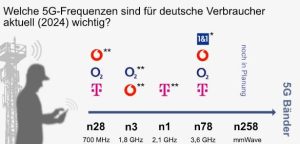What Are the Bands Comprising 5G FR2?
Introduction to 5G FR2 Bands
The 5G Frequency Range 2 (FR2) is synonymous with high-frequency bands, commonly known as millimeter waves (mmWave). These bands operate in the spectrum from 24.25 GHz to 52.6 GHz. The implementation of FR2 bands is crucial for delivering ultra-high-speed data services and capacity in densely populated areas. This range is fundamentally different from the sub-6 GHz frequencies of FR1, as it focuses on providing vast bandwidth over smaller geographic areas.

Detailed Look at the Primary 5G FR2 Bands
Let's explore the specific bands that comprise the 5G FR2 spectrum, highlighting their respective frequency ranges and typical applications:
- n257 (26.5 GHz to 29.5 GHz): This band is prominent for its extensive use in urban and suburban areas, providing high data throughput for applications requiring intense bandwidth.
- n258 (24.25 GHz to 27.5 GHz): Known for its early deployment, n258 is a critical band for initial 5G rollouts in cities, offering significant improvements in network capacity.
- n260 (37 GHz to 40 GHz): This band is tailored for extremely high-density areas, such as stadiums and concert venues, where massive amounts of data are consumed in a compact space.
- n261 (27.5 GHz to 28.35 GHz): While similar to n257 and n258, n261 is specifically optimized for slightly different geographic and regulatory environments.
Advantages of High-Frequency Bands
The primary advantage of these high-frequency bands is their ability to support enormous data traffic, a necessity for modern applications like high-definition video streaming, augmented reality, and more. The high bandwidth available in these bands allows for unprecedented data transmission speeds, albeit over shorter distances compared to FR1.
Challenges and Deployment Considerations
Despite their advantages, FR2 bands face challenges such as higher attenuation and sensitivity to physical obstructions, including buildings and trees. To effectively utilize these bands, telecom operators deploy dense networks of small cells, which are crucial for maintaining robust connectivity. These small cells amplify the coverage and ensure continuous service availability, particularly in urban settings where obstacles are more prevalent.
Global Impact and Future Outlook
The global rollout of 5G FR2 bands is underway, with varying degrees of adoption depending on regional regulatory environments and infrastructure readiness. As technology advances, the integration of FR2 bands is expected to become more widespread, supporting an array of new applications and services that leverage their high-speed capabilities.
Strategic Importance of FR2
FR2 bands are not merely an enhancement over existing technologies but a transformative shift in how wireless networks operate. They offer the potential to unlock new technological frontiers, pushing the boundaries of connectivity, speed, and efficiency in the 5G era. The strategic deployment of these bands is set to revolutionize communication, redefining user experiences and enabling future innovations.